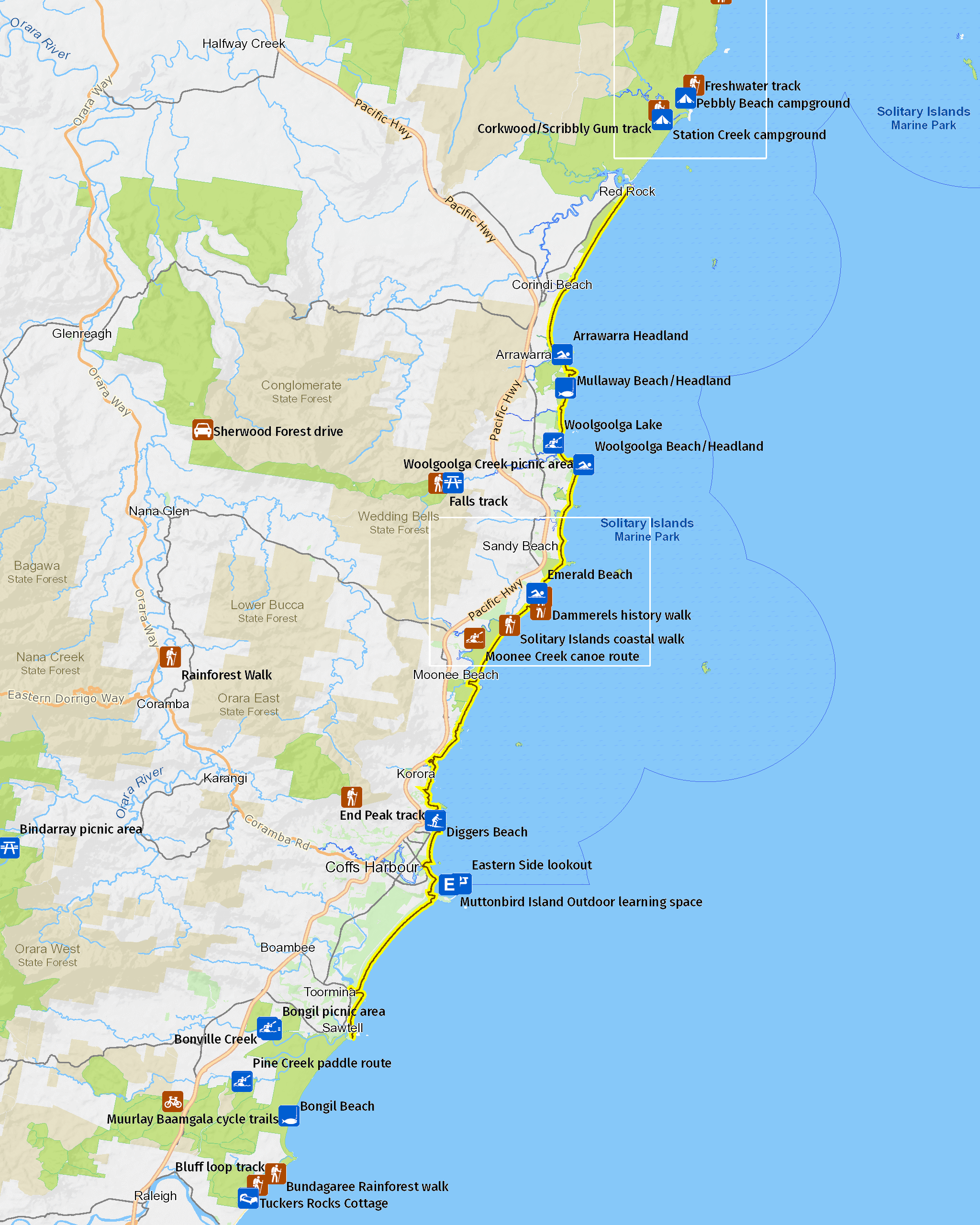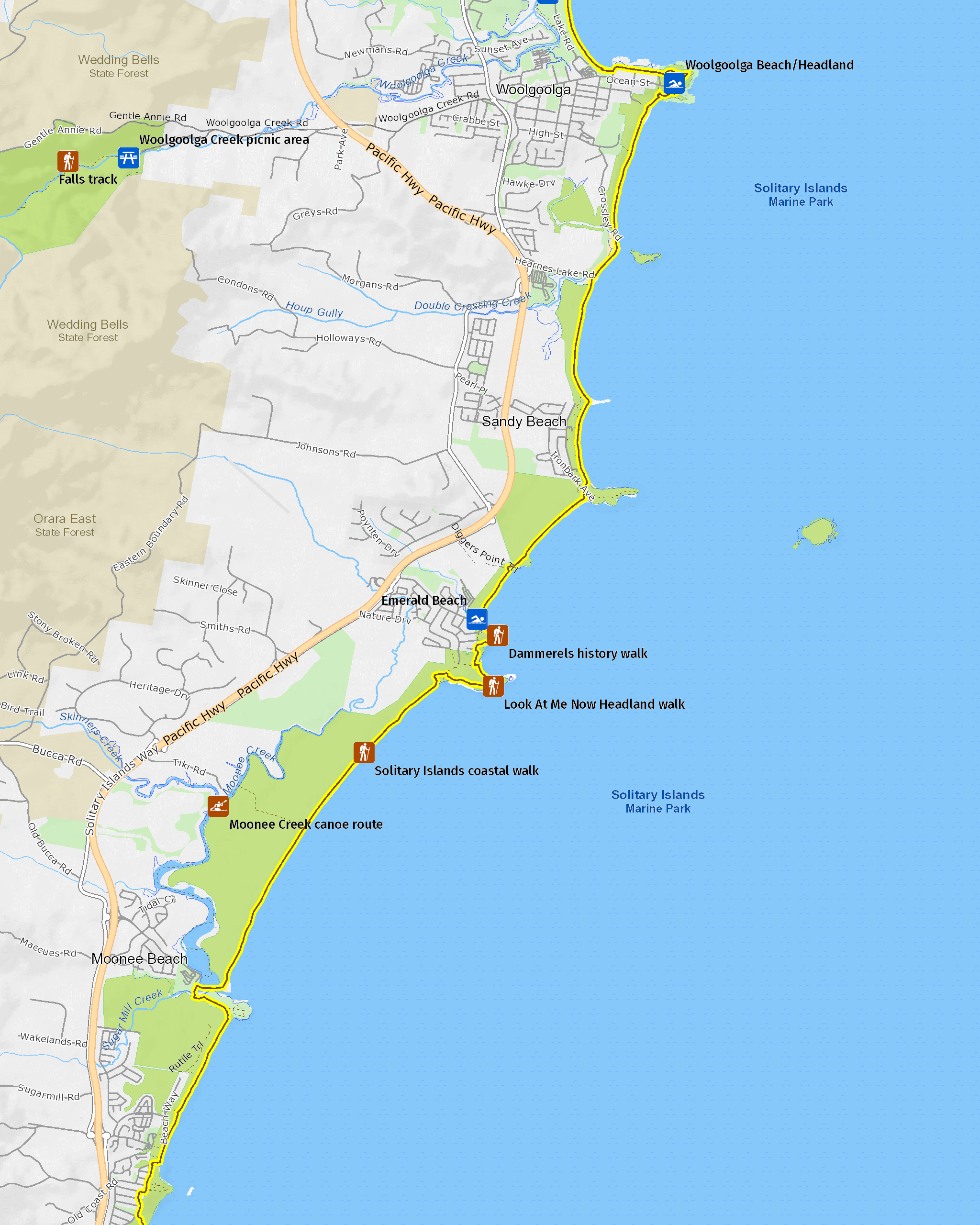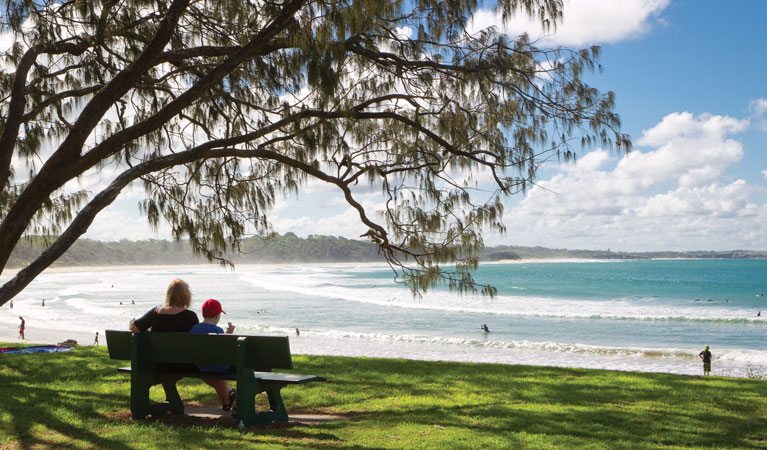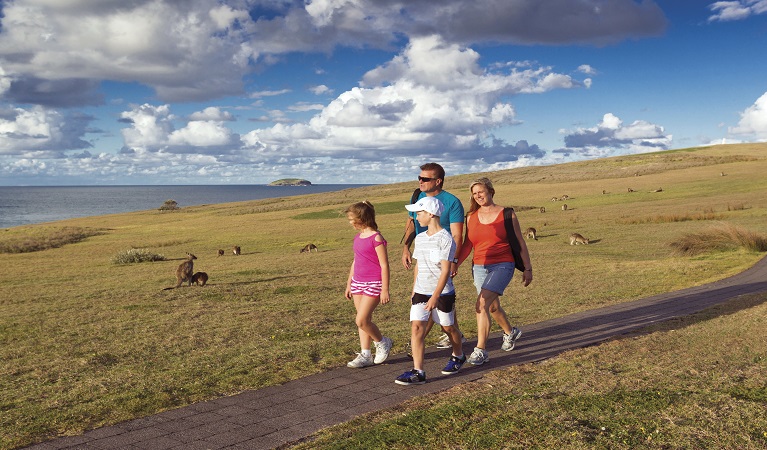Solitary Islands coastal walk
North Coast
Overview
Solitary Islands coastal walk traverses 60km of beaches and rainforest on the Coffs Coast. Enjoy whale watching, birdwatching and swimming on your journey from Red Rock to the coastal village of Sawtell.
- Accessibility
- No wheelchair access
- Distance
- 60km one-way
- Time suggested
- 3 - 4 days
- Grade
- Grade 4
- Trip Intention Form
-
It's a good idea to let someone know where you're going. Fill in a trip intention form to send important details about your trip to your emergency contact.
- Please note
- Check the tides - walking along the beach is easiest at low tide. Areas that are best walked at low tide include creek crossings at Arrawarra and Moonee Creek and around rocks on Campbells Beach.
You’ll be hard pressed to find a more beautiful walk on the east coast of NSW. The Solitary Islands coastal walk links a string of idyllic golden beaches, rocky headlands and lush rainforest along the Coffs Coast.
Make your way through Coffs Coast Regional Park, Moonee Beach Nature Reserve and Muttonbird Island Nature Reserve before winding up at Sawtell, near Bongil Bongil National Park.
Solitary Islands and Muttonbird Island are picturesque and make for perfect birdwatching, so bring your binoculars; little terns and white bellied eagles are often seen along the shores. Dolphins surf the waves of these beaches all year round and the headlands are ideal for whale watching.
There are plenty of options for picnicking, swimming and water sports. And with loads of nearby cafes and accommodation to suit any budget, you’ll want to keep coming back to discover all the charms of this beautiful walking track.
If you’re feeling energetic, pack your backpack and do the whole walk and camp over four days. Or why not stroll along the coastal walk in shorter sections, accessed from Arrawarra Headland, Woolgoolga Beach and Headland, Emerald Beach, Diggers Beach, and nearby Muttonbird Island Nature Reserve.
Map

Map

Map legend

Local alerts
For the latest updates on fires, closures and other alerts in this area, see https://www.nationalparks.nsw.gov.au/things-to-do/walking-tracks/solitary-islands-coastal-walk/local-alerts
General enquiries
- National Parks Contact Centre
- 7am to 7pm daily
- 1300 072 757 (13000 PARKS) for the cost of a local call within Australia excluding mobiles
- parks.info@environment.nsw.gov.au
Park info
- in Coffs Coast Regional Park in the North Coast region
Coffs Coast Regional Park is always open but may have to close at times due to poor weather or fire danger.
- in Moonee Beach Nature Reserve in the North Coast region
Moonee Beach Nature Reserve is always open but may have to close at times due to poor weather or fire danger.
Visitor info
All the practical information you need to know about Solitary Islands coastal walk.
Maps and downloads
Learn more
Solitary Islands coastal walk is in Coffs Coast Regional Park. Here are just some of the reasons why this park is special:
Life’s a beach

Golden beaches are the park’s premier attraction. Here, everything revolves around the water – whether you’re swimming and surfing in it, or walking and fishing beside it. Spend your days discovering the headland walking tracks, boat ramps, parklands and playgrounds. And no matter where you go, you’re bound to find a perfect spot for a beachside picnic. There are also plenty of dog-friendly areas at Coffs Coast Regional Park – just another of its popular features. Take your dog for a walk along one of the coastal paths, plus, there are several beaches with leash-free zones, meaning your pooch can zip about and enjoy the sand and sea as much as you do. The leash-free area around Corindi and Pipeclay beaches is a local favourite.
- Arrawarra Headland Soak up views of Solitary Islands Marine Park from Arrawarra Headland and Beach near Coffs Harbour. Fishing, surfing, swimming – it’s all here waiting for you to enjoy.
- Diggers Beach Located opposite the Big Banana in Coffs Harbour, Diggers Beach is excellent for surfing and learning to surf, plus fishing, swimming, birdwatching and beach walking.
- Emerald Beach Positioned near Look-at-me-now Headland, 20km from Coffs Harbour, Emerald Beach is a local surfing hotspot. Visit also for fishing or swimming, or for barbecues in the picnic area.
- Mullaway Beach and Headland Head south from Arrawarra to discover beautiful Mullaway Headland and Beach, near Coffs Harbour. Make the most of its picnic area and barbecues, go fishing or swimming.
Whale watchers

Coffs Coast Regional Park is a fantastic place to enjoy watching these majestic creatures on their long coastal journey. Look-At-Me-Now Headland near Emerald Beach is a great vantage point, but locals agree Woolgoolga Headland is your best bet for glimpsing humpbacks. In fact, it’s also known as ‘Whale Watch Headland’. Plan a trip between June and October to see this inspiring sight.
- Woolgoolga Beach and Headland Woolgoolga Beach and Headland has the best whale watching in the Coffs Region, plus great surfing, fishing and picnics and scenic views.
Plants and animals protected in this park
Animals
-

White-bellied sea eagle (Haliaeetus leucogaster)
White-bellied sea eagles can be easily identified by their white tail and dark grey wings. These raptors are often spotted cruising the coastal breezes throughout Australia, and make for some scenic bird watching. Powerful Australian birds of prey, they are known to mate for life, and return each year to the same nest to breed.
-

Brown-striped frog (Lymnastes peronii)
One of the most common frogs found in Australia, the ground-dwelling brown-striped frog lives in ponds, dams and swamps along the east coast. Also known as the striped marsh frog, this amphibian grows to 6.5cm across and has a distinctive ‘tok’ call that can be heard all year round.
-

Yellow-tailed black cockatoo (Calyptorhynchus funereus)
The yellow-tailed black cockatoo is one of the largest species of parrot. With dusty-black plumage, they have a yellow tail and cheek patch. They’re easily spotted while bird watching, as they feed on seeds in native forests and pine plantations.
-

Short-beaked echidna (Tachyglossus aculeatus)
One of only 2 egg-laying mammals in the world, the short-beaked echidna is one of the most widespread of Australian native animals. Covered in spines, or quills, they’re equipped with a keen sense of smell and a tube-like snout which they use to break apart termite mounds in search of ants.
-

Eastern blue-tongue lizard (Tiliqua scinciodes)
The eastern blue-tongue lizard, one of the largest skinks in Australia, is found throughout most of NSW. When threatened, the eastern blue-tongue lizard displays its blue tongue in a wide-mouthed intimidating show. Not an agile animal, they feed on slow-moving beetles and snails.

